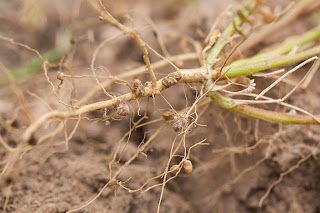I'm trying to answer the plant biology
question: why does nitrogen make leaves? (Which is something my mum
told me.) This led me to look at the nitrogen cycle and I started off
investigating how nitrogen from the atmosphere is converted to
ammonia (nitrogen fixation). This can be done industrially but in the biological
world it's done by nitrogen fixing bacteria.
Nitrogen in the form of ammonia can be
taken up by plant roots and as such is a bit useful to them, but not
that useful. It gets even more useful by being converted into
nitrate. This is a two step process and is called nitrification.
- In the first step ammonia (NH3) is converted to nitrite (NO2-)
- In the second step nitrite is converted to nitrate (NO3-)
In
the plant world nitrification, like fixation, involves specific
micro-organisms.
 |
| Nitrosomonas europeae Stan Watson, Woods Hole Oceanographic Institute http://genome.jgi-psf.org/niteu/niteu.home.html |
In
the second step the main group of bacteria that are involved in
converting nitrite to nitrate are called Nitrobacter.
Like in nitrogen fixation the micro-organisms involved in nitrification use specific enzymes to facilitate the conversions(3).
Unlike nitrogen fixation, in which the bacteria need energy (in the form of ATP) to convert atmospheric nitrogen to ammonia, nitrification actually releases energy that the micro-organisms use to make ATP (which then provides energy for other purposes). The term to describe this type of organism is a chemoautotroph – loosely translated meaning “obtaining own energy from a chemical reaction”.
Unlike nitrogen fixation, in which the bacteria need energy (in the form of ATP) to convert atmospheric nitrogen to ammonia, nitrification actually releases energy that the micro-organisms use to make ATP (which then provides energy for other purposes). The term to describe this type of organism is a chemoautotroph – loosely translated meaning “obtaining own energy from a chemical reaction”.
The micro-organisms involved in both steps can be found in a wide
range of environments, including, importantly for the purposes of my
investigation, soil.
One
of the important things about nitrate is that it is much more water
soluble than ammonia, which means that it is easier for plants to
take it up through their roots, and
why it is most useful.
Nitrite is also quite water soluble but is toxic to plants in large
amounts so it is important that it is converted to nitrate.
Interestingly,
nitrate can be formed directly when lightning strikes. The energy in
a bolt of lightning enables atmospheric nitrogen to be directly
combined with atmospheric oxygen. The resulting nitrate is soluble in
moisture in the atmosphere and when it rains the nitrate is delivered
to the soil, from where the plants take the nitrate up through their
roots(4).
So now we've found out how:
1. Atmospheric nitrogen is converted to ammonia
2. Ammonia is converted to nitrite and then to nitrate
Next
I'm going to be looking at how the plants take nitrate up through
their roots and what they then do with the nitrogen. This
will involve a little break from the nitrogen cycle (don't worry
we'll be coming back to it) and a diversion into cell biology.
References
(1) http://www.microbeworld.org/types-of-microbes/archaea accessed 17.8.13
(2) Bernhard, A. (2012) The Nitrogen Cycle: Processes, Players, and Human Impact. Nature Education Knowledge 3(10):25 Available http://www.nature.com/scitable/knowledge/library/the-nitrogen-cycle-processes-players-and-human-15644632 accessed 17.8.13
(3) http://nitrificationnetwork.org/Introduction.php accessed 17.8.13






